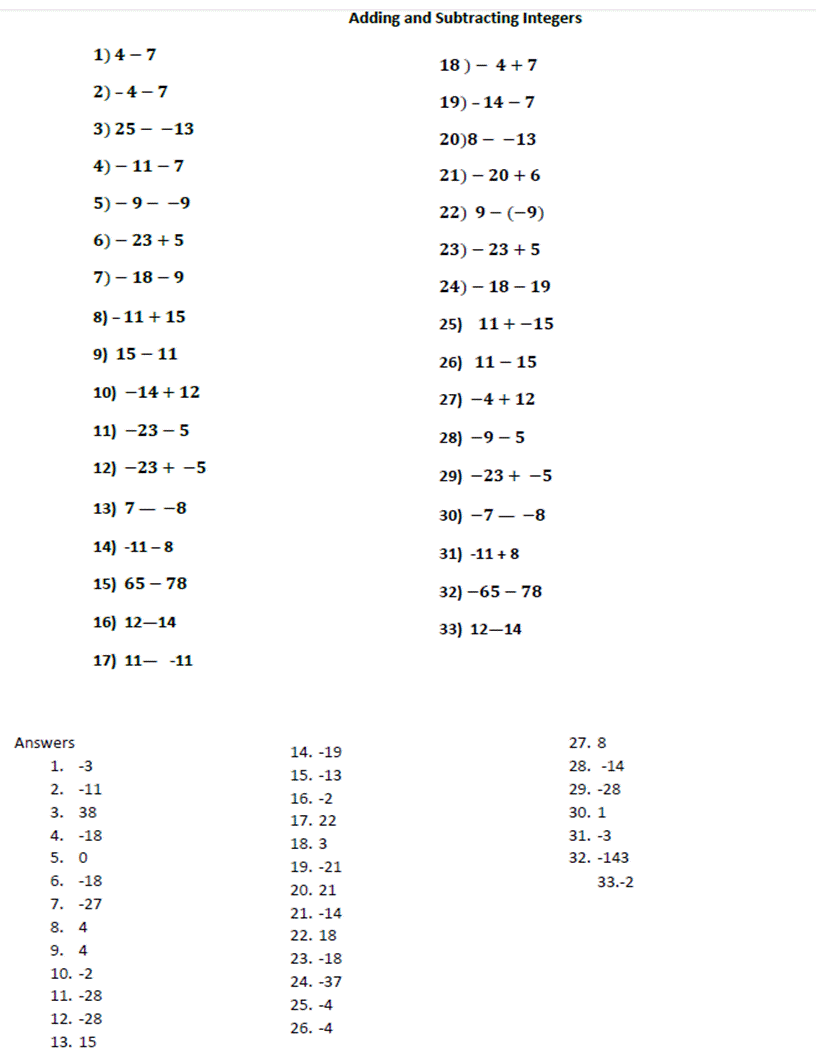Conquering the World of Integers: Adding and Subtracting Like a Pro
Ever wonder how to handle those pesky negative numbers? Adding and subtracting integers can seem daunting at first, but it's a fundamental skill that unlocks a whole world of mathematical understanding. From balancing your budget to understanding temperature changes, integer operations are everywhere. This comprehensive guide will equip you with the knowledge and confidence to tackle any integer problem, no matter how complex.
Imagine you're hiking a mountain. Going uphill is like adding a positive number, increasing your altitude. Going downhill? That's like subtracting, or adding a negative number, decreasing your altitude. Integers are simply whole numbers, both positive and negative, and zero. They represent real-world quantities that can increase or decrease.
The concept of negative numbers has been around for centuries, with evidence of their use dating back to ancient China. Initially, negative numbers were often seen as representing debts or losses. However, their importance grew as mathematics and its applications developed. Adding and subtracting integers is crucial for everything from basic arithmetic to advanced algebra, calculus, and beyond. Without a solid grasp of these operations, further exploration of mathematics becomes incredibly challenging.
One of the main hurdles people encounter with integer operations is understanding the rules governing the interaction of positive and negative signs. For example, adding a negative number is the same as subtracting its positive counterpart. Subtracting a negative number, on the other hand, is equivalent to adding its positive counterpart. These concepts can be confusing at first, but with practice and a clear understanding of the underlying principles, they become second nature.
Let's define some terms. An integer is a whole number (not a fraction) that can be positive, negative, or zero. Adding integers means combining their values. Subtracting integers involves finding the difference between their values. For instance, 5 + (-3) is equivalent to 5 - 3, which equals 2. Similarly, 5 - (-3) is equivalent to 5 + 3, which equals 8.
One benefit of mastering integer operations is improved financial literacy. Managing your budget, calculating profits and losses, and understanding interest rates all involve working with positive and negative numbers. Another benefit is enhanced problem-solving skills in various fields. Whether you're a scientist, engineer, or simply tackling everyday challenges, the ability to manipulate integers is invaluable. Finally, understanding integers lays the foundation for more advanced mathematical concepts. It's a stepping stone to algebra, calculus, and beyond.
An action plan for mastering integer operations might involve starting with basic addition and subtraction problems, gradually increasing the complexity. Practice regularly, using flashcards or online resources. Seek help from a tutor or teacher if needed. A successful example would be someone consistently practicing integer problems and gradually improving their speed and accuracy.
Best practices for working with integers include visualizing a number line, using parentheses to avoid confusion with multiple signs, remembering the rules for adding and subtracting negative numbers, checking your work by estimating the answer, and practicing regularly.
Real-world examples: 1. Temperature changes (-5 degrees + 3 degrees = -2 degrees). 2. Bank balance ($100 - $120 = -$20). 3. Altitude changes (1000ft - 2000ft = -1000ft). 4. Football yardage (10 yards + (-5 yards) = 5 yards). 5. Stock market changes (5 points + (-2 points) = 3 points).
FAQ: 1. What is an integer? 2. What is the difference between adding and subtracting integers? 3. How do I add two negative integers? 4. How do I subtract a negative integer from a positive integer? 5. What are some real-world examples of integer operations? 6. What are some common mistakes to avoid? 7. What resources can I use to practice? 8. Why is it important to learn about integers?
Tips and tricks: Use the number line visualization. Remember that adding a negative is the same as subtracting a positive. Subtracting a negative is the same as adding a positive.
In conclusion, mastering the addition and subtraction of integers is a cornerstone of mathematical literacy. It's a skill that empowers you to navigate real-world scenarios involving positive and negative quantities, from personal finance to scientific calculations. While the rules might seem tricky at first, with practice and perseverance, anyone can conquer the world of integers. The benefits extend far beyond simple arithmetic, providing a solid foundation for more advanced mathematical concepts and problem-solving in various fields. Start practicing today, and unlock the power of integers!
Findlay oh courier obits
Exploring the depths a look at the google zero gravity underwater park concept
Unveiling the story of villers la ville abbey a journey through time













